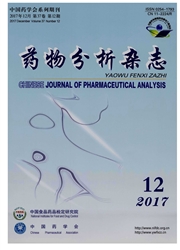

 中文摘要:
中文摘要:
Z-藁本内酯是中药川芎中主要的苯酞类化合物,具有神经保护、抗炎、抗增值及扩张血管等多种药理作用。但Z-藁本内酯在自然条件不稳定且易于降解,限制其研究和应用。本文采用HPLC-uv、UPLC-QTOF-MS和NMR对Z.藁本内酯室温自然光照下的降解行为及降解产物进行考察和鉴定,Z-藁本内酯完全降解后生成5个降解产物,2个降解产物通过与对照品对比确定为洋川芎内酯I和洋川芎内酯H,2个降解产物采用半制备HPLC分离后进行1H和13C NMR解析,确定其结构为(E)-6,7-反式.双羟基藁本内酯和(Z)-6,7-环氧藁本内酯。最后推测了Z-藁本内酯的降解途径,氧化、水解和异构化是主要的降解反应。
 英文摘要:
英文摘要:
Z-Ligustilide, a major phthalide isolated from a widely used traditional Chinese medicine Ligusticum chuanxiong, possesses various pharmacological activities including neuroprotective, anti-inflammatory, anti- proliferative and vasorelaxing effects. However, it is unstable and inclined to degrade in natural conditions, which limits its study and application greatly. In this study, degradation behavior of Z-ligustilide and its degradation products stored at room temperature under direct sunlight were investigated and structure elucidated by HPLC-UV, UPLC-QTOF-MS and NMR. Z-ligustilide degradation and total five degradation products were generated and detected. Two degradation products were unequivocally identified as senkyunolide I and senkyunolide H by comparison with reference compounds. Another two degradation products were further isolated by semi-preparative HPLC and structure elucidated as (E)-6, 7-trans-dihydroxyligustilide and (Z)-6, 7- epoxyligustilide by IH and 13C NMR, respectively. The degradation pathways of Z-ligustilide were finally proposed. Oxidation, hydrolysis and isomerization are the major degradation reactions.
 同期刊论文项目
同期刊论文项目
 同项目期刊论文
同项目期刊论文
 期刊信息
期刊信息
